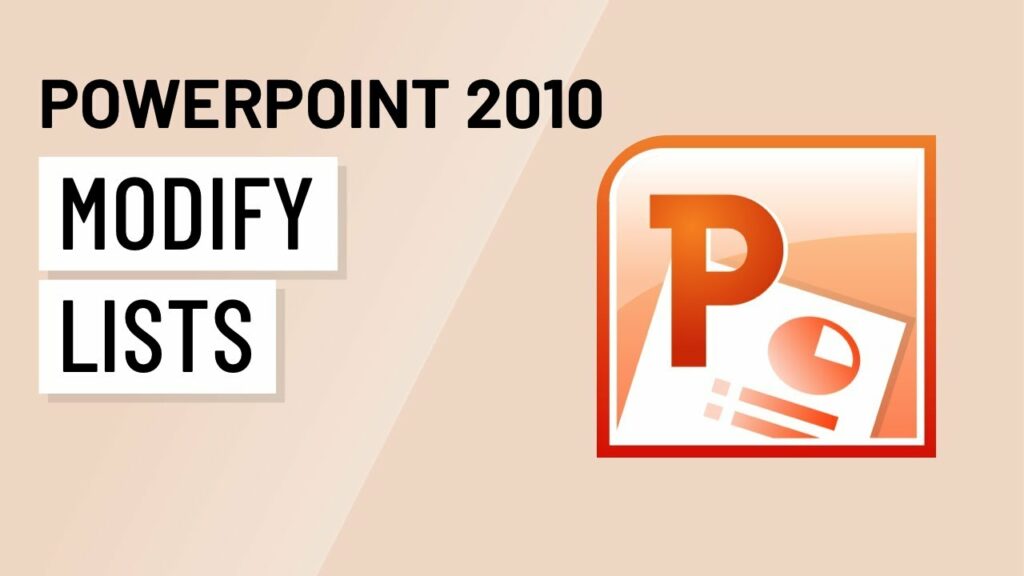Mastering List Modification in PowerPoint 2010: A Comprehensive Guide

Introduction:
Lists are a fundamental tool for organizing information and enhancing readability in presentations. Microsoft PowerPoint 2010 offers versatile features for creating and modifying lists, allowing presenters to customize their content and improve audience comprehension. In this comprehensive guide, we will explore the various methods and techniques for modifying lists in PowerPoint 2010, covering everything from basic list formatting to advanced customization options.
Section 1: Understanding the Importance of Lists in Presentations
1.1 The Role of Lists in Presentations: Lists serve as an effective way to organize and structure information in presentations, facilitating clarity and comprehension for the audience. Whether presenting key points, action items, or sequential steps, lists help break down complex information into digestible chunks, making it easier for audiences to follow along and retain information.
1.2 Enhancing Visual Hierarchy: Lists provide a visual hierarchy that guides the audience’s attention and emphasizes important points or steps. By formatting lists with appropriate indentation, bullet styles, and spacing, presenters can create a clear visual hierarchy that highlights key information and improves overall slide readability.
1.3 Promoting Audience Engagement: Well-structured lists help maintain audience engagement by presenting information in a concise and organized manner. Lists allow presenters to convey information efficiently, keeping the audience focused and interested in the presentation content.
Section 2: Creating and Formatting Lists in PowerPoint 2010
2.1 Creating Bulleted Lists: To create a bulleted list in PowerPoint 2010, follow these steps:
- Place your cursor in the text placeholder or text box where you want to create the list.
- Press the Enter key to start a new line.
- Press the Tab key to create an indented sub-item or the Shift + Tab keys to promote a sub-item to a higher level.
- Type your list items, pressing Enter after each item.
2.2 Formatting Bulleted Lists: PowerPoint 2010 offers a variety of formatting options for customizing bulleted lists, including:
- Bullet Styles: Choose from a range of built-in bullet styles or customize bullet shapes and sizes.
- Indentation: Adjust the indentation of list items to create hierarchical levels and improve visual hierarchy.
- Text Formatting: Apply font styles, colors, and sizes to list items for emphasis and consistency.
2.3 Creating Numbered Lists: In addition to bulleted lists, PowerPoint 2010 supports numbered lists for presenting sequential steps or ordered information. To create a numbered list, follow the same steps as for creating a bulleted list, but choose the Numbering option from the Paragraph group on the Home tab to apply numbering to the list items.
Section 3: Advanced List Customization Techniques
3.1 Customizing List Styles: PowerPoint 2010 allows users to customize list styles to match the presentation’s design aesthetic or branding guidelines. Users can modify bullet or numbering styles, adjust spacing and alignment, and create custom list templates for consistent formatting across slides.
3.2 Using SmartArt for Lists: SmartArt graphics offer a visually appealing way to present lists and hierarchical information in PowerPoint 2010. Users can choose from a variety of SmartArt layouts, such as lists, process diagrams, or organizational charts, and customize them to suit their specific needs.
3.3 Animating Lists: To add visual interest and interactivity to lists, users can apply animation effects to list items in PowerPoint 2010. By animating list items to appear sequentially or with other custom effects, presenters can engage the audience and draw attention to key points during the presentation.
Section 4: Best Practices for Effective List Modification
4.1 Keep Lists Concise: Avoid overwhelming the audience with lengthy lists or excessive detail. Keep lists concise and focused on essential information to maintain audience attention and comprehension.
4.2 Use Consistent Formatting: Maintain consistency in list formatting throughout the presentation to create a cohesive and professional look. Use consistent bullet or numbering styles, indentation levels, and text formatting to ensure visual coherence across slides.
4.3 Prioritize Information: Organize lists to prioritize important information and highlight key points or action items. Use indentation, bullet size, or font formatting to visually distinguish between primary and secondary information within lists.
4.4 Test for Readability: Before finalizing list formatting, test the readability of lists by reviewing them in Slide Show mode. Ensure that list items are legible and clearly visible, even from a distance, to accommodate audience viewing.
Conclusion:
Mastering list modification in PowerPoint 2010 is essential for creating clear, organized, and visually appealing presentations that effectively convey information to audiences. By understanding the importance of lists, mastering basic and advanced formatting techniques, and following best practices for effective list modification, presenters can enhance the readability, engagement, and impact of their presentations. Whether presenting key points, action items, or sequential steps, lists provide a versatile tool for organizing information and guiding audience comprehension in PowerPoint 2010. With practice, experimentation, and attention to detail, presenters can leverage the power of lists to create compelling and memorable presentations that resonate with their audience.




